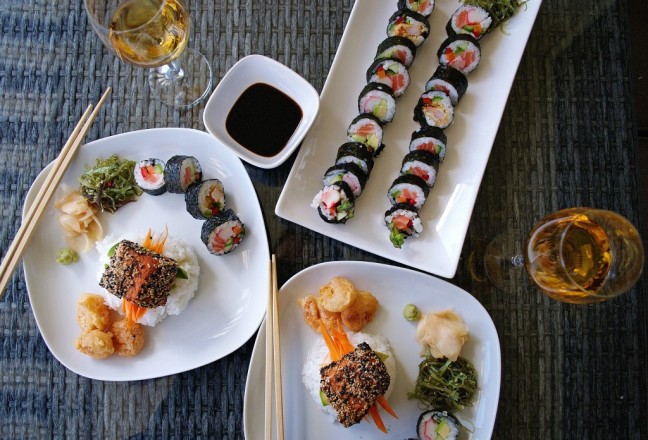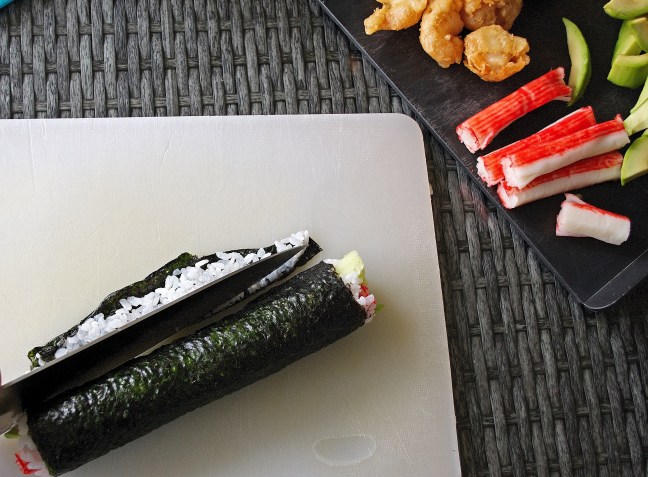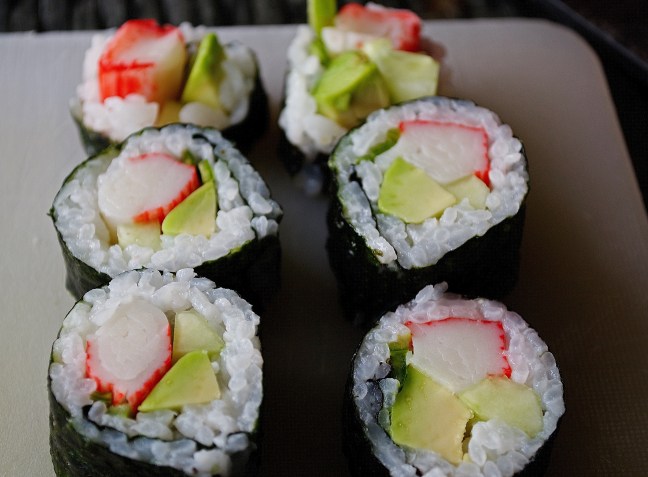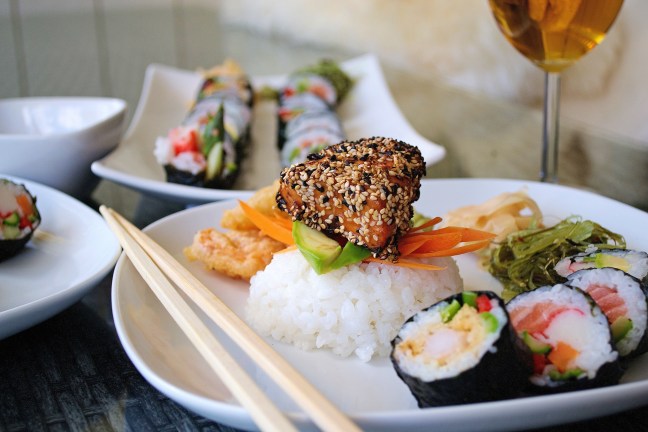Sushi is as much intimidating to eat for some as it is to make for others. Fortunately, for those who love to eat this beautiful Japanese dish, making it isn’t all that difficult. First off, clarifying the term sushi can be helpful. When most Westerners refer to sushi, they’re actually grouping three main types together: Nigiri (pressed rice and a thin slice of fish), Maki (sushi rolled in nori (seaweed)), and Sashimi (very thinnly sliced raw fish), though sashimi isn’t technically sushi at all. In this post, I’ll just be focusing on my personal favorite – Makizushi. This isn’t so much a recipe post, as it is just a list of tips I follow whenever I want to make sushi at home.
The first and most important part of sushi is getting the rice correct. Always follow the package directions and exercise some good judgement. Sushi rice are short, fat grains that are very sticky and starchy. You want to make sure you rinse your rice and let it soak before cooking it. Another important element for the rice is the seasoning. Sushi rice should be seasoned with rice vinegar and sugar or just mirin. Sushi rice is delicate and should have a sweet and acidic balance.
When prepping your fillings, keep in mind the width of the nori, and when possible, also cut the fillings to the same width or longer. Obviously this isn’t possible with everything, for instance avocados, but it will make rolling and cutting much easier for beginners. Which brings me to another point, use a sharp knife. There is absolutely no substitute for a razor sharp knife.
As you may notice, my bamboo sushi mat is covered in plastic. I do this to keep clean up to a minimum. It’s not necessary, but it’s become a habit. As you prep your station, always keep a pitcher of cold water close by. You’ll need this while handling the rice and as well, the cutting. So lay the nori down on the sushi mat and lightly moisten with wet hands. This will make the nori easier to work with, and prevent it from cracking. Then, again with wet hands, spread out the rice, leaving at least 1 inch (2.54 centimetres) on both ends. Begin neatly piling your filling into the center.
When you’re ready to roll, simply hold the sushi mat by the bottom and lift over the filling. Press down evenly across the mat and then shape the mat around the sushi roll. Pull the bottom of the mat away from you in order to roll it. For true beginners this is where I suggest you watch a couple how-to videos on Youtube.
If you have any excess nori, dip your knife in the cold water and slice it off the roll.
Cut your maki roll in half, and then cut each half into halves.
Then halve each of those pieces. The thinner the bites get, the more difficult it is to have tightly packed pieces.
Here you can see that this maki is just a simple California roll with crab stick, avocado, and cucumber.
Different fillings I use are, salmon, crab stick, scampi tempura, carrot, avocado, cucumber, asparagus, red bell pepper, and green chilies. What you choose is entirely up to you. My only tip here is to use the freshest ingredients and be sure any raw fish you use is sashimi grade and has never been frozen.
And finally, my last tip is be creative. Sushi doesn’t have to be the primary focus of a dish, although it will be of most people’s attention. Sushi works really well as a dish alongside a piece of teriyaki salmon or chicken. A little piece of anything tempera provides a crispy texture. And lastly, don’t forget the condiments: soya sauce, pickled ginger, wasabi, and wakeme. Below is my recipe for tempera batter.
Tempera Batter
- 315mL (10.65 fluid ounces) rice flour
- 250mL (8.45 fluid ounces) all-purpose flour
- 2 tbsp cornstarch
- 2 tsp baking powder
- 1 tsp salt
- 500mL (16.91 fluid ounces) carbonated soda water, very cold
- 1L (0.26 gallons) peanut oil (first choice) or sunflower oil
1. Combine all the dry ingredients together and whisk in the cold water. The batter should be fairly thin.
2. Place the batter in the fridge while the oil heats, though don’t make it too far ahead or the water will go flat.
3. Heat the oil to 190°C (374 degrees Fahrenheit). Dip whatever you want to cook in the batter and drop into the hot oil. If frying scampi, then no more than 2 minutes. Fish fillets, about 3-5 minutes depending on the thickness, and chicken 4-6 minutes depending on the thickness.














